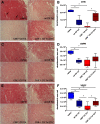Interaction of the hydrogen sulfide system with the oxytocin system in the injured mouse heart
- PMID: 30341744
- PMCID: PMC6195501
- DOI: 10.1186/s40635-018-0207-0
Interaction of the hydrogen sulfide system with the oxytocin system in the injured mouse heart
Abstract
Background: Both the hydrogen sulfide/cystathionine-γ-lyase (H2S/CSE) and oxytocin/oxytocin receptor (OT/OTR) systems have been reported to be cardioprotective. H2S can stimulate OT release, thereby affecting blood volume and pressure regulation. Systemic hyper-inflammation after blunt chest trauma is enhanced in cigarette smoke (CS)-exposed CSE-/- mice compared to wildtype (WT). CS increases myometrial OTR expression, but to this point, no data are available on the effects CS exposure on the cardiac OT/OTR system. Since a contusion of the thorax (Txt) can cause myocardial injury, the aim of this post hoc study was to investigate the effects of CSE-/- and exogenous administration of GYY4137 (a slow release H2S releasing compound) on OTR expression in the heart, after acute on chronic disease, of CS exposed mice undergoing Txt.
Methods: This study is a post hoc analysis of material obtained in wild type (WT) homozygous CSE-/- mice after 2-3 weeks of CS exposure and subsequent anesthesia, blast wave-induced TxT, and surgical instrumentation for mechanical ventilation (MV) and hemodynamic monitoring. CSE-/- animals received a 50 μg/g GYY4137-bolus after TxT. After 4h of MV, animals were exsanguinated and organs were harvested. The heart was cut transversally, formalin-fixed, and paraffin-embedded. Immunohistochemistry for OTR, arginine-vasopressin-receptor (AVPR), and vascular endothelial growth factor (VEGF) was performed with naïve animals as native controls.
Results: CSE-/- was associated with hypertension and lower blood glucose levels, partially and significantly restored by GYY4137 treatment, respectively. Myocardial OTR expression was reduced upon injury, and this was aggravated in CSE-/-. Exogenous H2S administration restored myocardial protein expression to WT levels.
Conclusions: This study suggests that cardiac CSE regulates cardiac OTR expression, and this effect might play a role in the regulation of cardiovascular function.
Keywords: Arginine-vasopressin receptor; Blood glucose; Cardiovascular system; Cystathionine-γ-lyase; GYY4137; Vascular endothelial growth factor.
Conflict of interest statement
Ethics approval
This is a post hoc study of material available from previous experiments that were performed in adherence to the National Institutes of Health Guidelines on the Use of Laboratory Animals and the European Union “Directive 2010/63 EU on the protection of animals used for scientific purposes.” and authorized by the federal authorities for animal research of the Regierungspräsidium Tübingen (approved animal experimentation number: 1130), Baden-Württemberg, Germany, and the Animal Care Committee of the University of Ulm, Baden-Württemberg, Germany.
Consent for publication
Not applicable
Competing interests
The authors declare that they have no competing interests.
Publisher’s Note
Springer Nature remains neutral with regard to jurisdictional claims in published maps and institutional affiliations.
Figures

Similar articles
-
ΔMST and the Regulation of Cardiac CSE and OTR Expression in Trauma and Hemorrhage.Antioxidants (Basel). 2021 Feb 3;10(2):233. doi: 10.3390/antiox10020233. Antioxidants (Basel). 2021. PMID: 33546491 Free PMC article.
-
Hydrogen Sulfide Treatment Improves Post-Infarct Remodeling and Long-Term Cardiac Function in CSE Knockout and Wild-Type Mice.Int J Mol Sci. 2020 Jun 16;21(12):4284. doi: 10.3390/ijms21124284. Int J Mol Sci. 2020. PMID: 32560137 Free PMC article.
-
A cardioprotective insight of the cystathionine γ-lyase/hydrogen sulfide pathway.Int J Cardiol Heart Vasc. 2015 Feb 7;7:51-57. doi: 10.1016/j.ijcha.2015.01.010. eCollection 2015 Jun 1. Int J Cardiol Heart Vasc. 2015. PMID: 28785645 Free PMC article.
-
The Role of Cystathionine-γ-Lyase In Blunt Chest Trauma in Cigarette Smoke Exposed Mice.Shock. 2017 Apr;47(4):491-499. doi: 10.1097/SHK.0000000000000746. Shock. 2017. PMID: 27685807
-
Targeting hydrogen sulfide as a promising therapeutic strategy for atherosclerosis.Int J Cardiol. 2014 Mar 15;172(2):313-7. doi: 10.1016/j.ijcard.2014.01.068. Epub 2014 Jan 24. Int J Cardiol. 2014. PMID: 24491853 Review.
Cited by
-
Brain Histology and Immunohistochemistry After Resuscitation From Hemorrhagic Shock in Swine With Pre-Existing Atherosclerosis and Sodium Thiosulfate (Na2S2O3) Treatment.Front Med (Lausanne). 2022 Jun 30;9:925433. doi: 10.3389/fmed.2022.925433. eCollection 2022. Front Med (Lausanne). 2022. PMID: 35847799 Free PMC article.
-
The Effect of Targeted Hyperoxemia on Brain Immunohistochemistry after Long-Term, Resuscitated Porcine Acute Subdural Hematoma and Hemorrhagic Shock.Int J Mol Sci. 2024 Jun 14;25(12):6574. doi: 10.3390/ijms25126574. Int J Mol Sci. 2024. PMID: 38928283 Free PMC article.
-
Localization of the hydrogen sulfide and oxytocin systems at the depth of the sulci in a porcine model of acute subdural hematoma.Neural Regen Res. 2021 Dec;16(12):2376-2382. doi: 10.4103/1673-5374.313018. Neural Regen Res. 2021. PMID: 33907009 Free PMC article. Review.
-
Cerebral Immunohistochemical Characterization of the H2S and the Oxytocin Systems in a Porcine Model of Acute Subdural Hematoma.Front Neurol. 2020 Jul 7;11:649. doi: 10.3389/fneur.2020.00649. eCollection 2020. Front Neurol. 2020. PMID: 32754111 Free PMC article.
-
The Role of Glucocorticoid Receptor and Oxytocin Receptor in the Septic Heart in a Clinically Relevant, Resuscitated Porcine Model With Underlying Atherosclerosis.Front Endocrinol (Lausanne). 2020 May 14;11:299. doi: 10.3389/fendo.2020.00299. eCollection 2020. Front Endocrinol (Lausanne). 2020. PMID: 32477273 Free PMC article.
References
-
- Elrod JW, Calvert JW, Morrison J, Doeller JE, Kraus DW, Tao L, Jiao X, Scalia R, Kiss L, Szabo C, Kimura H, Chow CW, Lefer DJ. Hydrogen sulfide attenuates myocardial ischemia-reperfusion injury by preservation of mitochondrial function. Proc Natl Acad Sci U S A. 2007;104(39):15560–15565. doi: 10.1073/pnas.0705891104. - DOI - PMC - PubMed
-
- Kondo K, Bhushan S, King AL, Prabhu SD, Hamid T, Koenig S, Murohara T, Predmore BL, Gojon G, Sr, Gojon G, Jr, Wang R, Karusula N, Nicholson CK, Calvert JW, Lefer DJ. H2S protects against pressure overload-induced heart failure via upregulation of endothelial nitric oxide synthase. Circulation. 2013;127(10):1116–1127. doi: 10.1161/CIRCULATIONAHA.112.000855.. - DOI - PMC - PubMed
Grants and funding
LinkOut - more resources
Full Text Sources
Research Materials

